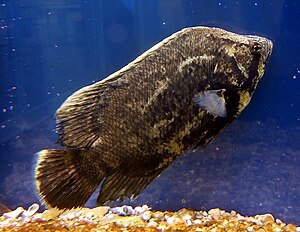Three-tailed perch
| Three-tailed perch | ||||||||||||
|---|---|---|---|---|---|---|---|---|---|---|---|---|

Lobotes surinamensis |
||||||||||||
| Systematics | ||||||||||||
|
||||||||||||
| Scientific name | ||||||||||||
| Lobotes | ||||||||||||
| Cuvier , 1830 |
The genus of the three-tailed perch ( Lobotes ) consists of two very similar species, Lobotes pacificus , which occurs in the eastern Pacific from the Gulf of California to Peru, and Lobotes surinamensis , which occurs almost worldwide near the coast in temperate, subtropical and tropical seas.
features
Three-tailed perches reach a maximum body length of 1.10 meters and have a high-backed body that has a brownish, piebald or marbled color. The caudal, dorsal and anal fin are rounded. The rounded, soft-rayed part of the dorsal and anal fin extends far back, giving the impression of three caudal fins. The head is triangular, the palate is toothless.
- Fins formula : dorsal VI – XII / 13–19, anals III / 8–18.
Young three- tailed perch resemble leaves floating in the water ( mimicry ) and let themselves be carried around passively with the waves. They only flee when you have come within a few centimeters. Eggs and larvae are likely to be pelagic.
Systematics
The genus Lobotes was introduced in 1830 by the French naturalist Georges Cuvier . Three-tailed perches, tiger perches ( Datnioides ) and the genus Hapalogenys , which used to belong to the sweetlips and grunts family (Haemulidae), are closely related. In Joseph S. Nelson's Fishes of the World , a standard work on fish systematics, Lobotes together with Datnioides form the family Lobotidae , which was introduced in 1861 by the American ichthyologist Theodore Nicholas Gill . The Australian ichthyologists Anthony Gill and Jeffrey M. Leis also introduced Hapalogenys into the Lobotidae in October 2019 . At the same time they put the Lobotidae in the order of the surgeon fish-like (Acanthuriformes). The Lobotidae share a unique trait (a synapomorphism ) with the rest of the surgeonfish , which was used to diagnose the order. In the larvae and adult specimens of the Lobotidae and the other surgeonfish species, the regrowing teeth grow on the outside of the jaw and replace their predecessors in groups.
species
- Lobotes pacificus Gilbert in Jordan & Evermann, 1898
- Lobotes surinamensis (Bloch, 1790)
literature
- Baensch, Patzner: Mergus Sea Water Atlas Volume 7 Perciformes (perch-like) . Mergus-Verlag, Melle 1998, ISBN 3-88244-107-0 .
Individual evidence
- ↑ Lobotes on Fishbase.org (English)
- ↑ Jeffrey M. Leis & Anthony C. Gill: Tigerfishes, Tripletails, and Velvetchins form a clade: Morphological evidence from adults and larvae. “International Symposium on Systematics and Diversity of Fishes” on March 3-4, 2008 at the National Museum of Nature and Science, Tokyo
- ^ Joseph S. Nelson, Terry C. Grande, Mark VH Wilson: Fishes of the World. Wiley, Hoboken, New Jersey, 2016, ISBN 978-1118342336 , p. 503 et al. 504
- ↑ Anthony Gill & Jeffrey M. Leis (2019): Phylogenetic position of the fish genera Lobotes, Datnioides and Hapalogenys , with a reappraisal of acanthuriform composition and relationships based on adult and larval morphology. Zootaxa, 4680 (1): 1-81. DOI: 10.11646 / zootaxa.4680.1.1